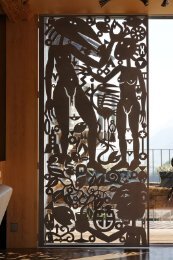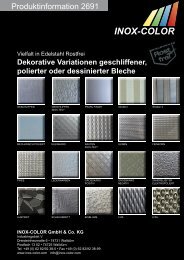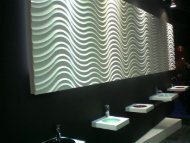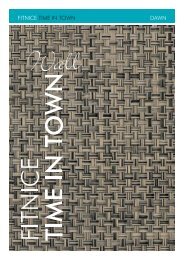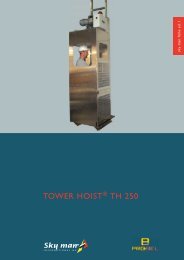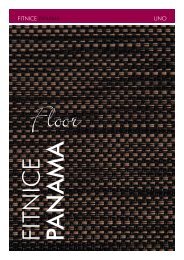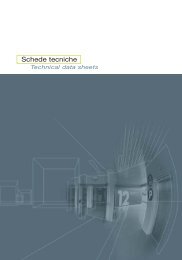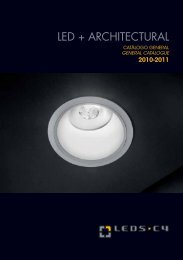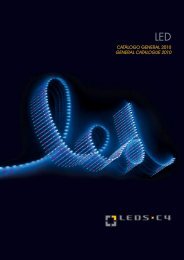Oltre il metallo -1- 20101112 p.1 - 42.cdr - DieMMe
Oltre il metallo -1- 20101112 p.1 - 42.cdr - DieMMe
Oltre il metallo -1- 20101112 p.1 - 42.cdr - DieMMe
You also want an ePaper? Increase the reach of your titles
YUMPU automatically turns print PDFs into web optimized ePapers that Google loves.
Il problema del rumore - The noise problem<br />
Pannelli Vibranti - Vibrating panels<br />
Pannelli vibranti<br />
Vibrating panels<br />
Un'altra importante categoria di<br />
materiali assorbenti è costituita<br />
dai pannelli vibranti, o in generale<br />
da sistemi suscettib<strong>il</strong>i di entrare in<br />
vibrazione. Quando un'onda<br />
sonora incontra un rivestimento<br />
capace di vibrare, si produrranno<br />
delle osc<strong>il</strong>lazioni più o meno<br />
ampie, che dipenderanno dal<br />
rapporto della frequenza del<br />
suono incidente con la frequenza<br />
propria del pannello. Queste<br />
osc<strong>il</strong>lazioni raggiungono <strong>il</strong><br />
massimo valore quando questo<br />
rapporto è uguale a uno, in tal<br />
caso si ha <strong>il</strong> fenomeno della<br />
risonanza.<br />
N e i p a n n e l l i v i b r a n t i i l<br />
meccanismo dell'assorbimento è<br />
dovuto essenzialmente alla<br />
trasformazione dell'energia<br />
sonora in lavoro di osc<strong>il</strong>lazione<br />
elastica e <strong>il</strong> coefficiente raggiunge<br />
i l m a s s i m o v a l o r e i n<br />
corrispondenza della frequenza di<br />
risonanza. Il pannello, eccitato<br />
dalle vibrazioni dell'aria, reagisce<br />
come se fosse un sistema elastico<br />
vibrando in maniera diversa a<br />
seconda delle sue condizioni di<br />
vincolo.<br />
Da quanto esposto si può<br />
i n t u i r e c h e i l f e n o m e n o<br />
dell'assorbimento dell'energia<br />
sonora è influenzato dalle<br />
dimensioni e dalla rigidezza del<br />
pannello, dalle sue condizioni di<br />
vincolo e dalla presenza di camere<br />
d'aria o cavità risuonatrici. Inoltre<br />
<strong>il</strong> fenomeno è di natura selettiva,<br />
con andamento diverso alle varie<br />
frequenze. Risulta evidente che le<br />
proprietà fonoassorbenti di un<br />
controsoffitto non dipendono<br />
soltanto dal tipo di materiale<br />
impiegato, ma possono mutare<br />
più o meno sensib<strong>il</strong>mente in<br />
relazione alle modalità di<br />
montaggio. Ai fini pratici è<br />
interessante la conoscenza delle<br />
c u r v e c h e r a p p r e s e n t a n o<br />
l'andamento del coefficiente di<br />
assorbimento in funzione della<br />
frequenza. Nel diagramma sono<br />
riportate alcune curve. Si può<br />
notare la grande differenza<br />
esistente tra la superficie dei muri<br />
in mattoni pieni (che si comporta<br />
come uno specchio acustico nei<br />
riguardi del suono) e la superficie<br />
occupata da un pubblico fitto<br />
(sale da spettacolo) che assorbe<br />
una notevole quantità di energia<br />
sonora.<br />
Nello stesso diagramma si vede<br />
anche che per i materiali porosi<br />
(lana di vetro, ecc.) l'andamento<br />
delle curve è crescente, mentre<br />
per i pannelli vibranti (legno<br />
compensato con intercapedine) la<br />
c u r v a c h e r a p p r e s e n t a i l<br />
coefficiente d'assorbimento è<br />
ondulata e ciò è dovuto a<br />
fenomeni di risonanza.<br />
Sull'assorbimento ha influenzato<br />
lo spessore del materiale;<br />
generalmente aumentando lo<br />
spessore cresce <strong>il</strong> coefficiente.<br />
Vibrating panels, or, generally<br />
speaking, systems liable to start<br />
vibrating, constitute another<br />
important category of absorbent<br />
materials. When a sound wave<br />
meets a covering that can vibrate,<br />
osc<strong>il</strong>lations of varying extent are<br />
produced, which w<strong>il</strong>l depend on<br />
the ratio between the frequency<br />
of the incident sound and the<br />
panel's own frequency. These<br />
osc<strong>il</strong>lations peak when this ratio<br />
equals one, in which case the<br />
resonance phenomenon is<br />
encountered. In vibrating panels,<br />
the absorption mechanism is<br />
e s s e n t i a l l y d u e t o t h e<br />
transformation of sound energy<br />
into elastic osc<strong>il</strong>lation action, and<br />
the coefficient reaches the<br />
maximum value at the resonance<br />
frequency. The panel, excited by<br />
the air's vibrations, reacts as<br />
though it were an elastic system,<br />
vibrating in a different manner<br />
depending on its fixing systems.<br />
We can deduce from the above<br />
explanations that the sound<br />
energy absorption phenomenon<br />
is affected by the size and<br />
stiffness of the panel, by its fixing<br />
systems and by whether there are<br />
resonating cavities or air<br />
c h a m b e r s . M o r e o v e r, t h e<br />
phenomenon is of a selective<br />
nature, behaving differently at<br />
different frequencies.<br />
Clearly, the sound-absorbent<br />
properties of a false ce<strong>il</strong>ing do not<br />
depend just on the type of<br />
material used, but can differ to a<br />
α<br />
1<br />
0,8<br />
0,6<br />
0,4<br />
0,2<br />
varying extent depending on how<br />
they are mounted. For practical<br />
purposes, fam<strong>il</strong>iarity with the<br />
sound absorption coefficient<br />
versus frequency curves proves<br />
helpful. The diagram features a<br />
number of curves.<br />
We can see the big difference<br />
between the surface of the solid<br />
brick walls (which act like an<br />
acoustic mirror to sound) and the<br />
surface taken up by a large<br />
audience (entertainment halls),<br />
which absorbs a considerable<br />
amount of sound energy. In the<br />
same diagram, we can also see<br />
that the curves for porous<br />
materials (fibreglass etc.) have an<br />
upward trend, wh<strong>il</strong>st for vibrating<br />
panels (plywood with air gap), the<br />
c u r v e r e p r e s e n t i n g t h e<br />
absorption coefficient rises and<br />
falls as a result of the resonance<br />
phenomenon.<br />
Absorption has been affected by<br />
material thickness: generally<br />
speaking, the coefficient rises as<br />
thickness increases.<br />
Curva relativa al coefficiente di assorbimento acustico di pannelli vibranti<br />
Curve relating to the sound absorption coefficient of vibrating panels<br />
0<br />
0 125 165 205 250 330 410 500 700 800 1000 1330 1670 2000 2670 3340 4000<br />
Hz<br />
con intecapedine riempita di materiale assorbente<br />
with gap f<strong>il</strong>led with absorbent material<br />
con intecapedine vuota<br />
with empty gap<br />
5.06




